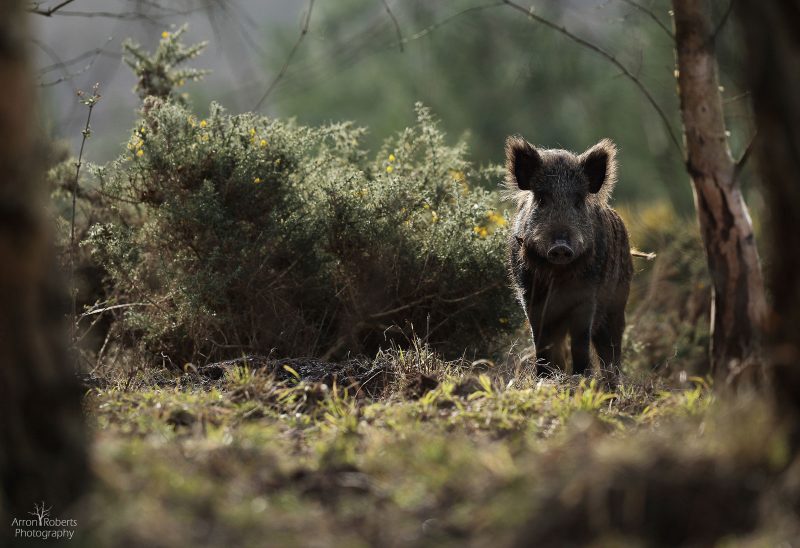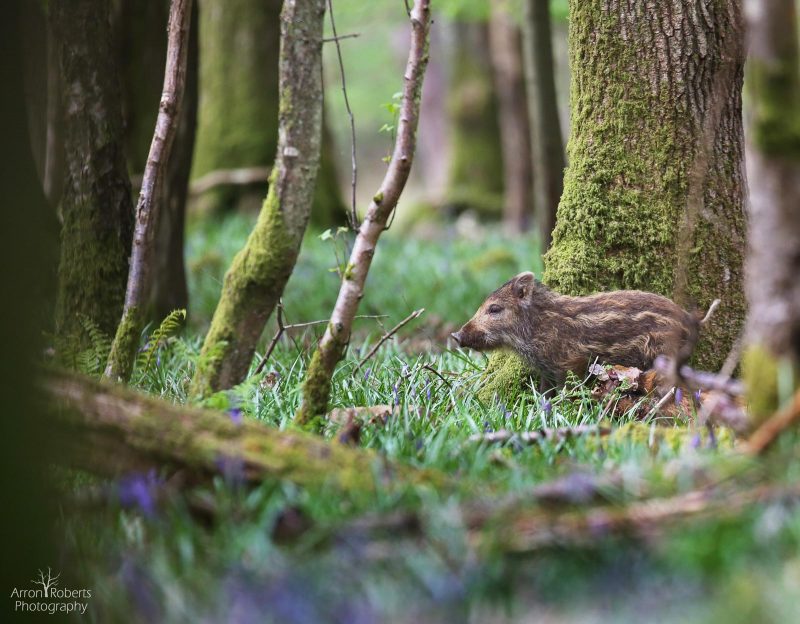How to Photograph Wild Boar in the Forest of Dean

There are four main areas in the UK where wild boar exist, with the largest population being in the Forest of Dean. The Forestry Commission survey the population annually using thermal imaging cameras, counting the individuals at night. They originally escaped from a farm towards Ross on Wye in 1999 with a further group being dumped near Staunton in 2004. Breeding prolifically every year, the population has boomed with an estimate of 1562 individuals in 2016. Photographing wild boar in the Forest of Dean is difficult, but it’s definitely possible.
Habitat preference is determined by food availability and they will move to different locations throughout the year. Wild Boar are omnivorous, eating pretty much anything they come across. In winter, their main diet consists of seeds such as acorns and beech masts turning to broadleaf grasses and roots throughout the summer months. During autumn, soft roadside verges will be uprooted as they search for worms and invertebrates; gardens and other public areas are also easy to turn over which leads to a divided opinion amongst locals who either love or hate them. Road traffic incidents have increased over the years and dog walkers have expressed their concerns after some unfortunate encounters.



How to Find Wild Boar in the Forest of Dean
There is now a large population throughout the forest and signs of their presence are easy to find, but actually finding the boar themselves can be challenging. The most obvious sign is their rooting behaviour. When tracking them down, pay attention to smaller animal paths; their cloven hooves leave prints with two slots and sometimes the rear dew claw is present in the right conditions. Deer will leave a similar two slot print but they are rounded and appear to point inwards. Boar droppings are larger and clump together, more like sheep whereas deer will be in pellet form. Hair maybe caught on old fence lines and trees are often used for a rub after bathing in a muddy wallow.

During the day, boar will typically lay up in cover such as bracken stands, dark conifer plantation, or overgrown clearfells, moving out to feed during the evening and overnight. An area that provides a mixture of forest habitats with places to hide and a good food source would be an ideal spot to look. Go out early morning and evenings for the softer light and to avoid the dog walkers. There are plenty of areas around between Cinderford and Coleford and you shouldn’t need to go far from the car to find them.

Fieldcraft
You will need to wear dull clothing or camouflage to blend into the surroundings. A camouflage vail or neck warmer to cover your face, a cap or beanie and possibly gloves to try and conceal any features of your body that will stand out. Other options would be to use a bag hide or a pop-up hide placed on a frequently used area.
Read more: 8 Tips for Approaching Animals Without Being Noticed
Patience
Wild boar have a superb sense of smell and hearing, but their eyesight is poor. Once you have located a group, observe them for a while to understand their behaviour. If you can see one or two there is a high chance there will be more close by. Listen out for rustling and movement within the vegetation, or squeals and grunts as they squabble between themselves. Take into consideration wind direction; make sure your scent is drifting away from the boar. You should watch which way they are moving and plan your route to get closer. Look for cover to hide behind and take note of what is on the ground in front of you. Be as slow and quiet as possible and avoid treading on small branches that may snap or crunchy leaves during autumn. It can sometimes take a couple of hours to get to a position suitable for photographs, so be patient.

Gear
For frame-filling shots the longer the focal length the better, 400mm+ on a full frame camera. Even then you will need to be within metres of the boar. The ideal lens would be a zoom as you can never tell what may happen with wildlife, how close they may come or the change in lighting and composition may suit a wider angle shot. Lenses that have low apertures such as f2.8/ f4 will allow more light in so a lower ISO can be used. Full frame cameras will also handle higher ISOs better.
- My equipment
- Canon 5d iii
- Canon 300mm f2.8 ii
- Canon 100-400mm f4.5-5.6 ii
- Canon 24-105mm f4
- Canon 1.4x converter iii
- Swarovski 8×32 el binoculars
The majority of the time I use the 300mm lens, which has superior image quality and allows more light in with the wide aperture. With a more specific shot in mind, the 100-400mm is the ideal lens to include more of the environment. Binoculars are essential for observing wildlife at a distance without them seeing you first.

Camera Settings
Personally, I use aperture priority mode, manually setting the aperture and ISO. Because of the poor lighting conditions in a forest I often shoot wide open at f4 to allow the most light in, keeping the ISO as low as possible. Aperture priority mode will then select the fastest shutter speed possible. Always try to stay above 1/200th.
- Aperture priority mode
- Wide aperture – f2.8, f4, f5.6 depending on your lens.
- Lowest ISO possible- I rarely go above 4000
- The highest shutter speed that the conditions allow- lowest 1/200th with a steady hand
- A manually selected single autofocus point.
Another benefit of using a wide aperture is to isolate the subject and produce a clean and out of focus background, however, f2.8 is a shallow depth of field and if you are close to the subject you may find that not all the features are in focus. Manually selecting the autofocus point allows you to compose the shot, usually in a third of the frame and to also focus on the eyes of the subject. Another option would be to use back button focusing.

An ethical approach
I’ve never felt threatened or in danger but they’re still wild animals and can be unpredictable. Generally, the boar will run off at the first sign of your presence however when sows have young they can stand their ground to protect their family. Show respect and give them plenty of space to move away safely. Once you have been spotted, never pursue the group and instead allow them to carry on in peace. I have seen young piglets in almost every month of the year, but a higher percentage occur during early spring. This is a sensitive time so try not to go looking too often. It is also followed by the bird breeding season with several forest species, including schedule 1 listed birds, choosing to nest on the ground. Under the wildlife and countryside act 1981, it is illegal to intentionally or unintentionally disturb them during these times. For more information see our guide to Understanding Schedule 1 Licenses.

Finally, enjoy the moment, every encounter is unique and can never predict what may happen next. Take time to watch and appreciate these animals as you can often miss the experience while looking through the camera all the time.





